Although there have been numerous investigations of biolinguistics within the Minimalist Program over the last ten years, many of which appeal to the importance of Turing’s Thesis (that the structural design of systems must obey physical and mathematical laws), these studies have by and large ignored the question of the structural design of language. They have paid significant attention to identifying the components of language - settling on a lexicon, a computational system, a sensorimotor performance system and a conceptual-intentional performance system; however, they have not examined how these components must be inter-structured to meet thresholds of simplicity, generality, naturalness and beauty, as well as of biological and conceptual necessity. In this book, Stroik and Putnam take on Turing’s challenge. They argue that the narrow syntax - the lexicon, the Numeration, and the computational system - must reside, for reasons of conceptual necessity, within the performance systems. As simple as this novel design is, it provides, as Stroik and Putnam demonstrate, radical new insights into what the human language faculty is, how language emerged in the species, and how language is acquired by children.





